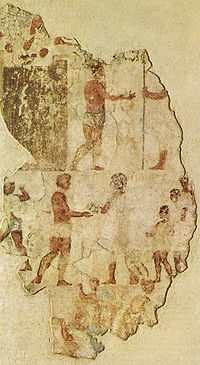
Esquiline Necropolis
Encyclopedia

Necropolis
A necropolis is a large cemetery or burial ground, usually including structural tombs. The word comes from the Greek νεκρόπολις - nekropolis, literally meaning "city of the dead"...
on the Esquiline in Rome, in use until the end of the 1st century AD.
It came into use when the Forum necropolis fell into disuse in the mid 8th century BC (other than for child burials, which continued there until the end of the 7th century BC), and testifies to Rome's expansion towards Velia
Velia
Velia is the Italian name of the ancient town of Elea located on the territory of the comune of Ascea, Salerno, Campania, Italy in a geographical sub-area named Cilento...
. Its burials have richer grave goods and are better supplied with weapons, typical of a now aristocratic warrior-class, as already existed in other areas along the Tyrrhenian
Tyrrhenian Sea
The Tyrrhenian Sea is part of the Mediterranean Sea off the western coast of Italy.-Geography:The sea is bounded by Corsica and Sardinia , Tuscany, Lazio, Campania, Basilicata and Calabria and Sicily ....
seaboard such as Etruria and Campania. As regards the protohistoric period, the burials are of the advanced "second phase" and, more typically, the "third phase", characterized by more compressed-form (rather than globular-form) pots, with more elongated handles towards the top and more "costolature" than moulded or carved decoration.
See also
- Prehistoric tombs at the
- Arch of AugustusArch of Augustus, RomeThe Arch of Augustus was the triumphal arch of Augustus in the Roman Forum. Dedicated in 29 BC, it commemorates the great battle of Actium against Antony and Cleopatra...
("Sub-Apennine" phase) - Temple of Antoninus and FaustinaTemple of Antoninus and FaustinaThe Temple of Antoninus and Faustina is an ancient Roman temple in Rome, adapted to the church of San Lorenzo in Miranda. It stands in the Forum Romanum, on the Via Sacra, opposite the Regia.-The temple:...
(first phase "Latin", second phase "Roman")
- Arch of Augustus
- PalatinePalatine HillThe Palatine Hill is the centermost of the Seven Hills of Rome and is one of the most ancient parts of the city...
huts

